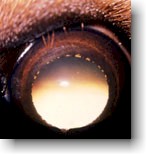Table of Contents
Summary:
"Canine distichiasis is a condition where eyelashes grow out of glands that do not normally produce eyelashes. If they irritate or rub against the eye they can cause irritation or possibly a corneal ulcer. Treatment involves destroying the hair follicle with surgery or plucking out the eyelash. Even with treatment, lashes may grow out of different locations."
Overview
This condition occurs when eyelashes grow in places that they shouldn't. In this case there is a gland in the eye called a Meibomian gland that should not produce eyelashes. In distichiasis the gland grows eyelashes which rub against the eye causing irritation. The condition can occur on only 1 or all 4 of your dog's eyelids. If left untreated this condition can possibly lead to the formation of a corneal ulcer.

Breeds That Have a High Incidence of Distichiasis
Breeds that tend to get distichiasis problems include:
- Golden Retrievers
- Labrador Retrievers
- Miniature Long-Haired Dachshund
- English Cocker Spaniel
- American Cocker Spaniel
- Poodles
- Shih Tzus
- Weimeranas
Symptoms of Dog Distichiasis
There are several symptoms associated with distichiasis in dogs:
- Redness
- Squinting
- Discharge
- Rubbing the eye
Treatment of Canine Distichia
Treatment depends on the number of eyelashes (also called cilia) growing from the gland and whether the extra eyelashes are causing discomfort or eye irritation. Your veterinarian will also determine if eyelashes are growing from all 4 dog eyelids.
If they are, then the extra eyelashes can be pulled out, trimmed, removed using electrolysis (destruction of the follicle using electricity), or surgically removed. Other approaches include using heat to destroy the hair follicles that are allowing the eyelashes to grow. The follicles can also be frozen using a technique called cryosurgery.
No matter what you do there is a likelihood that the eyelashes will grow back if not in the same area, in a different area.
Ointments can be used to protect the eye from the irritating eyelashes.
Sources
A.V.C.O.
Hereditary Diseases of the Canine Eyelid and Cornea
Peter Bedford, Professor
Royal Veterinary College
Department of Veterinary Clinical Sciences
Hawkshead Lane
Hatfield, Hertfordshire AL9 7TA, UK
